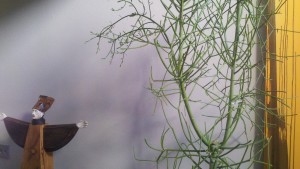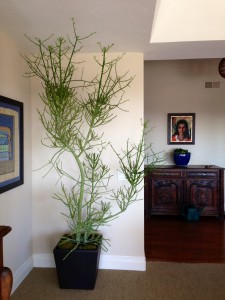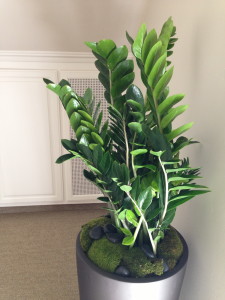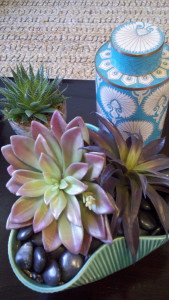So, everyone knows that succulents are the new ‘it plant’. You see them popping up in front yards everywhere you look. They are a wonderful choice in Southern California and Orange County from the inland desert areas to coastal regions. They are drought tolerant, have interesting textures and shapes, and magnificent colors year-round! I am a definite proponent of the
succulent movement! Plus, you pretty much just pop them into the ground, avoid over-watering and Voila, a garden transformation is made!
All that sounds fun and easy, because it is, but running a primarily
Interior Plant Design and Maintenance Company we have not always been so successful with succulents when growing indoors with mostly low light. For as easy as they grow in the exterior, in the interior they do the complete opposite and become bug infested, rotten and leggy overnight. But the artist inside of me wouldn’t give up and I have become determined to grow succulents indoors! Through a lot of trial and decease, I have had a few breakthrough plants I would love to share with you.
Succulents come in so many interesting shapes and forms, they add to a space, just like a beautiful piece of art enlivens a room. My all time favorite Succulent Indoors would have to be the Pencil Cactus, Euphorbia tirucalli. This plant has proven to me that it can handle lower light while keeping its gorgeous architectural form. It will always need some natural light, but I’ve really tested this plant and as long as you don’t over water, it can be put in a medium light room with ease.
Two stand out plants, more common in the interior world, but definitely worth a mention for their versatility and hardiness. First, is Sansevieria ‘Snake Plant’ (comes in a lot of different varieties, some growing only 6 inches, others as tall as 4 feet). Second, is the Zamioculcas zamiifolia ‘ZZ Plant. Both of these plants can be used in a modern design and take very little care. The big bonus to these succulents are they can take medium to low light!
So, the key to finding succulents that will grow and thrive indoors is to find plants that grow SLOW! I’m still continuing to experiment, but I have had good luck with Aloe varieties, Haworthia varieties, Agaves, Euphorbias and Kalanchoe ‘Flap Jack’.
And if you just have a brown thumb, you can always resort to replica succulents! I’m not shy to use these in low light situations
and they look great when combined with living plants!
If you’ve had luck with growing succulents indoors please leave me a comment and tell me what you’re growing! Let’s share the knowledge and continue to grow together!
If you can’t get enough, click here for a few more awesome succulents in your home!


-223x300.jpg)









The house we just bought has succulents around the perimeter of the house and we love it! I pretty much have a brown thumb, but the aloe plant we’ve had in our house has done quite well over the past couple of years. I’ll have to look further into bringing more succulents to the inside of my home.
Plants inside your home always add a warmth that the furniture and art work can’t provide. Let me know if you need help choosing plants for your new home!
Great article.
I’ve always heard that succulents would never grow well indoors, so as much as I love their interesting textures and shapes, I have just avoided bringing them into my interior design.
I have never heard of the Pencil Cactus. Yes indeed it has a great architectural form. I also love the shade of green and shape of both the Snake Plant and ZZ Plant.
Thanks again for such an informative article. Oh, and I love all the pictures. It really puts it in perspective how indoor succulents can improve your interior environment.
Thanks Jason!
All of the pictures are of plants that I care for in the Orange County area and everything is doing great too! I appreciate your feedback!
Aloe has always been in our house. I never knew it was considered succulents! We had it on hand for medicinal purposes (burns from the stove, etc). The one in my house now sits on along side a window and grows like crazy! If I transfer it to another poor/planter will it stunt its growth?
Great article! Super informative! Thanks!
Great to hear that you have been so successful with your Aloe succulent! It’s a wonderful healing plant and definitely good to have around the kitchen. Transplanting your Aloe won’t stunt it’s growth, it will actually help it grow faster. You can also divide your Aloe into separate plants, 2 or more. The main tip is to always use cactus soil and make sure your pot or planter has a drainage hole. Good luck!
Great article, and yes you even proved to me Pencil cactus can be grown indoors. Love the picture of the one you have posted, I think I helped you install that one, and wasn’t sure how it would do but it looks great!
Thanks Deb! Yes, without your help I don’t think I’d be able to carry that Pencil Cactus into the house. It was close to 7 feet tall!
I have a brown thumb but have had good luck with the ZZ plant. It’s beautiful, dark green and always has a sheen to it, and no wonder it hardly needs water…it’s a succulent!
I think it would be great to have an aloe plant in the house but don’t know how my cats would react to it. Great article!
Thanks Emi! Even if your cats decided to eat the Aloe plant, it wouldn’t harm them. Aloe juice and flesh can be added to smoothies for their healing properties internally. Let me know if you would like my help getting an Aloe for your home.
I don’t have any succulents in my house but how cute would these little
Haworthia succulents be in a center piece. And I could supplement them with some replica succulents or change them out according to the seasons. Thanks for this great insight into succulents.
Thanks Rissa! Yes, Haworthia succulents would be perfect for a center piece. One of my residential clients has a wooden low bowl on her dining room table that I plant Haworthia varieties in with artificial plants. They have been there for almost 3 years now and still look great!
I love succulents, they’re easy to water.
Just be careful not to over-water!